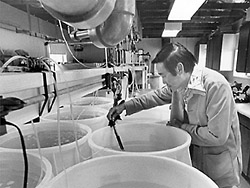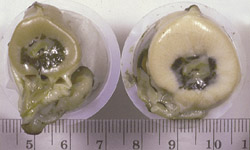| Triploid Oyster |
Close this window |
Through research carried out by University of Washington Fisheries Professor Kenneth Chew and his colleagues, Washington state has become one of the nation's top three producers of oysters. Chew is perhaps best known for developing the triploid Pacific oyster, which doesn't become "mushy" during the summer spawning season.
Triploid oysters have been genetically altered using controlled applications such as heat, pressure, or a chemical, so that they are reproductively inactive - virtually sterile - in summer months when other oysters are spawning. Triploids attain a larger size than normal, or diploid strains. |
 |
| And because triploids don't undergo the transformations associated with reproduction that make diploid oysters unpalatable during the summer months, they can be marketed year round. The old adage about not eating oysters unless there's an "r" in the month does not apply to triploids. |
 |
Triploids are genetically altered by interrupting the maturation process of the oyster egg cell so that the egg retains two sets of chromosomes, to which the sperm contribute another set, for a total of three. In the regular process, the egg cell reduces it chromosomes to one set, and the sperm contributes another set, resulting in the diploid organism. |
|
The triploid oyster became one of the first genetically altered organisms to catch the attention of the U.S. court of appeals, and later earned a patent from the U.S. Patent Office, a ruling of far reaching implications.
Compiled by Robin Lesh,
from Pathbreakers: Excellence in Science & Technology at the University of Washington, Debora L. Illman
Close this window
|

